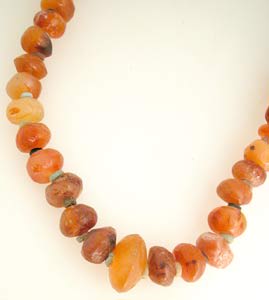Necklace Of Antique Carnelian And Faience Beads, 1900 BCE - 300 CE
Carnelian-Faience
FB.0002
Further images
Necklace consisting of genuine antique carnelian, and agate beads dating from the Middle Bronze Period to the Roman Period. The ancient Egyptians believed that fiery orange-red carnelian was the distilled...
Necklace consisting of genuine antique carnelian, and agate beads dating from the Middle Bronze Period to the Roman Period.
The ancient Egyptians believed that fiery orange-red carnelian was the distilled essence of the Sun's rays, and many of the jewels of the Pharaohs were carved from it. The name of this generally translucent variety of chalcedony comes from the Latin word for flesh, for that is what its warm reddish tones reminded the Romans of. Since earliest times, carnelian has been prized for its rich, radiant color like the heart of a glowing fire. Carnelian jewels have been discovered in the Royal tombs of Ur, Egypt and the Holy Land. One royal lady of ancient Jordan was found buried with a carnelian and gold necklace over ten feet in length. The Prophet Mohammed himself is said to have worn a ring set with this gem. As an amulet, carnelian is favored to act on the blood, preventing it from rising in excess to the head, stopping nosebleed, easing menstrual flow and causing blood to circulate smoothly throughout the body. It is believed to make the skin healthy and youthful, removing sores and blemishes when worn. Because of its calming effects on the blood, carnelian also makes one feel peaceful and slow to anger. It is theorized that the color orange is the harmonious balance of passionate, creative red and bright, cheerful yellow, which makes it particularly soothing to wear. Carnelian is the perfect stone to achieve that blissful state of balance.
Most ancient Egyptian beads were made of faience, a glass-composite glaze which was introduced as early as the Pre-Dynastic period. According to Egyptologists, most beads were made on an axis, probably of thread, which would burn up during firing, leaving a hole. Disc, ring and tubular beads were made by coating the axis with the unfired body-paste, rolling the cylinder to an even diameter on a flat surface, and then scoring it with a knife into sections of the desired length. Other shapes, such as ball beads, were rolled between the hands and perforated while still wet with a stiff point such as a wire needle. The beads were then dried, coating with glaze (if the glaze had not already been mixed with the paste), and fired. The firing process often gave the beads a beautiful translucent quality. The majority of faience beads are blue or green in color, but black, red yellow and white ones were also produced, especially in the New Egyptian Kingdom.
The ancient Egyptians believed that fiery orange-red carnelian was the distilled essence of the Sun's rays, and many of the jewels of the Pharaohs were carved from it. The name of this generally translucent variety of chalcedony comes from the Latin word for flesh, for that is what its warm reddish tones reminded the Romans of. Since earliest times, carnelian has been prized for its rich, radiant color like the heart of a glowing fire. Carnelian jewels have been discovered in the Royal tombs of Ur, Egypt and the Holy Land. One royal lady of ancient Jordan was found buried with a carnelian and gold necklace over ten feet in length. The Prophet Mohammed himself is said to have worn a ring set with this gem. As an amulet, carnelian is favored to act on the blood, preventing it from rising in excess to the head, stopping nosebleed, easing menstrual flow and causing blood to circulate smoothly throughout the body. It is believed to make the skin healthy and youthful, removing sores and blemishes when worn. Because of its calming effects on the blood, carnelian also makes one feel peaceful and slow to anger. It is theorized that the color orange is the harmonious balance of passionate, creative red and bright, cheerful yellow, which makes it particularly soothing to wear. Carnelian is the perfect stone to achieve that blissful state of balance.
Most ancient Egyptian beads were made of faience, a glass-composite glaze which was introduced as early as the Pre-Dynastic period. According to Egyptologists, most beads were made on an axis, probably of thread, which would burn up during firing, leaving a hole. Disc, ring and tubular beads were made by coating the axis with the unfired body-paste, rolling the cylinder to an even diameter on a flat surface, and then scoring it with a knife into sections of the desired length. Other shapes, such as ball beads, were rolled between the hands and perforated while still wet with a stiff point such as a wire needle. The beads were then dried, coating with glaze (if the glaze had not already been mixed with the paste), and fired. The firing process often gave the beads a beautiful translucent quality. The majority of faience beads are blue or green in color, but black, red yellow and white ones were also produced, especially in the New Egyptian Kingdom.





